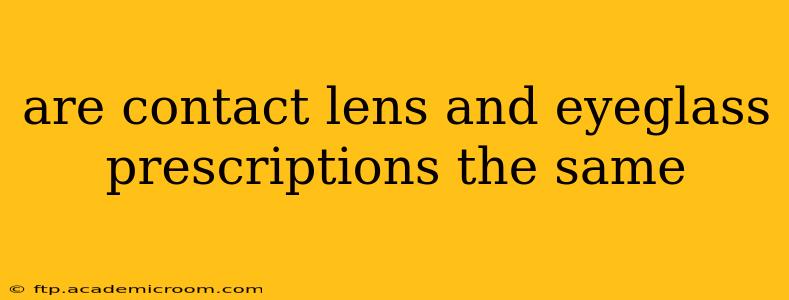Are Contact Lens and Eyeglass Prescriptions the Same?
No, contact lens and eyeglass prescriptions are not the same, despite measuring the same basic visual needs. While both correct refractive errors like nearsightedness (myopia), farsightedness (hyperopia), and astigmatism, the way they do so differs significantly, leading to different prescription values. This is because eyeglasses sit a distance away from the eye, while contact lenses rest directly on the cornea. This difference in placement necessitates different calculations to achieve optimal vision.
Here's a breakdown of the key distinctions:
Why are the prescriptions different?
The primary reason for the difference lies in the vertex distance. This refers to the distance between the eye and the corrective lens. Eyeglasses have a significant vertex distance, while contact lenses have a near-zero vertex distance. This seemingly small difference significantly impacts the refractive power needed to achieve clear vision. The calculation to account for this distance is crucial and is why an optometrist or ophthalmologist needs to perform a separate fitting for contact lenses.
What specific differences might you see?
You might notice differences in the following aspects of your prescription:
- Sphere (SPH): This corrects nearsightedness and farsightedness. The difference in SPH power is usually small but can be noticeable, especially for individuals with high refractive errors.
- Cylinder (CYL): This corrects astigmatism, the irregular curvature of the cornea. The cylinder power might vary slightly between the two prescriptions.
- Axis (AX): This indicates the orientation of the astigmatism correction. While usually the same, minor variations can occur.
- Base Curve (BC) and Diameter (DIA): These are crucial for contact lens prescriptions and are not found in eyeglass prescriptions. The base curve refers to the curvature of the contact lens, and the diameter refers to its size, both essential for proper fit and comfort.
What happens if I use my eyeglass prescription for contact lenses?
Using your eyeglass prescription for contact lenses can lead to several problems, including:
- Blurred vision: The incorrect power could result in blurry vision, making it difficult to see clearly.
- Eye strain and discomfort: Trying to compensate for blurry vision can lead to eye strain and headaches.
- Dry eyes: A poorly fitting contact lens, due to an incorrect prescription, can contribute to dryness and irritation.
- Increased risk of infection: An improperly fitted lens might not sit correctly on the eye, increasing the chance of debris getting underneath and causing infections.
Do I need a separate contact lens exam?
Yes, absolutely. Even if your eyeglass prescription is fairly recent, you need a separate eye exam specifically for contact lenses. This exam will assess the health of your cornea, determine the appropriate lens parameters (base curve, diameter), and provide a precise contact lens prescription. This ensures a safe and comfortable contact lens experience.
Can my optometrist or ophthalmologist help me?
Yes! Your eye care professional is the best resource for determining the appropriate prescription for both eyeglasses and contact lenses. They can explain the differences in detail and answer any specific questions you may have. Don't hesitate to ask them about the specifics of your prescriptions and the reasons for any discrepancies.
In conclusion, while both eyeglasses and contact lenses correct vision, their prescriptions are distinctly different due to the varied placement of the corrective lenses. Always consult your eye care professional for a proper fitting and prescription for both eyeglasses and contact lenses to ensure optimal vision and eye health.
